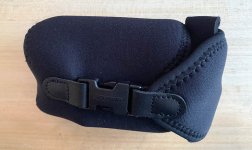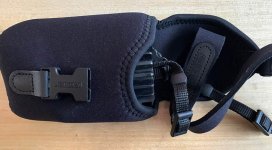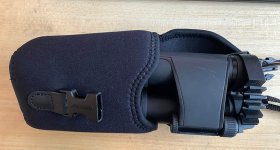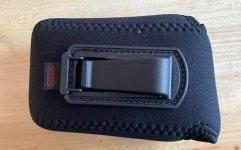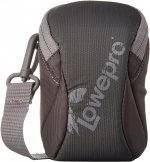This is not true. I have the Nikon as well. IS is great and they are compact. But:
- FOV is very small
- Eye placement is not easier, quite the contrary which is to be expected from a 10x25 compared to a 8x25
- Eye relief is smaller, a lot. The Zeiss is perfectly comfortable with glasses, the Nikon is not
- Zeiss image is better. The Nikon has a lot more CA and is not as transparent, not even as good as my 20 years old Trinovid.
- Focusing is easier on the Zeiss: more DOF, a better designed focuser
- the Nikon is heavier: more than 400g when the Zeiss is around 300g
- the Nikon rainguard fits only when they are closed. Adding caps would not be as easy as with the Zeiss
- the Nikon as no rubber cover, metal contact with, well anything, is no joy
- the Nikon IS switch can activate when stored especially when using their lightweight pouch, eating battery. And the binocular cannot be used without battery
- The Nikon is not really smaller: see picture
I bought the Nikon for a very specific usage: archery. They can have a lof of other uses.
But as a "always with you small binocular", they are clearly not in the same league as the compact Alphas.
Unless you need IS, they are not a good choice.
- FOV is very small
Of course the FOV on a 10x will be smaller than your 8x Zeiss. The FOV of the Nikon 10x25 IS is 294 feet@100yds which is the same as the Swarovski 10x25 CL-P so it is very comparable to an alpha 10x25.
- Eye placement is not easier, quite the contrary which is to be expected from a 10x25 compared to a 8x25
I agree the bigger exit pupil will help with eye placement on the 8x25 versus the 10x25 but because the IS stabilizes the image so eye placement is easier.
- Eye relief is smaller, a lot. The Zeiss is perfectly comfortable with glasses, the Nikon is not
That is true. The Zeiss 10x25 has 16.5mm of ER versus the Nikon 10x25 IS which has 14mm which could be an issue for eye glass wearers but not an issue if you don't wear glasses.
- Zeiss image is better. The Nikon has a lot more CA and is not as transparent, not even as good as my 20 years old Trinovid.
The Nikon will have more CA than the Zeiss because it is a 10x and the Zeiss is a 8x magnification. Higher magnification binoculars usually have more CA. I find the Nikon performs very well controlling CA for a 10x especially since it makes no mention of HD glass in the specifications. Transparency is subjective and I don't see that big of a difference in my Nikon's although they are probably not as transparent as NL's.
- Focusing is easier on the Zeiss: more DOF, a better designed focuser
An 8x will always have more DOF than a 10x. DOF is solely determined by the magnification. The focuser is subjective. What is better designed for one may not be for someone else.
- the Nikon is heavier: more than 400g when the Zeiss is around 300g
An IS binocular is going to have to be heavier than a normal binocular because of the weight of the IS mechanism. I think Nikon did pretty a good making it only 400 grams heavier.
- the Nikon rain guard fits only when they are closed. Adding caps would not be as easy as with the Zeiss
Nikon designed the rain guard to fit when the binoculars are closed because most people fold their compacts, so they can put them in their pocket. A rain guard that folds with the binoculars can be hard to fold.
- the Nikon as no rubber cover, metal contact with, well anything, is no joy
i find the Nikon's comfortable to hold and their binoculars like MHG line do not use a lot of rubber armour to keep the binoculars lighter. Armour adds weight, and they probably wanted to keep these new IS binoculars a light as they could be knowing they were going to be heavier anyway with the IS.
- the Nikon IS switch can activate when stored especially when using their lightweight pouch, eating battery. And the binocular cannot be used without battery
I don't know why you would want to use them without a battery. The IS is a huge advantage so why would you not want to use it? I have never accidentally turned on the IS switch but I use a Lowepro Dashpoint 10 case for mine which is stiffer.
- The Nikon is not really smaller: see picture
It is pretty close and it folds up smaller being double hinged for ease of putting in your pocket. I think the Nikon IS is pretty small for a 10x25 IS binocular.
-"I bought the Nikon for a very specific usage: archery. They can have a lot of other uses.
But as an "always with you small binocular", they are clearly not in the same league as the compact Alphas.
Unless you need IS, they are not a good choice."
I agree with most of that but if you want to see more detail than a traditional alpha compact you do need IS. So it is a matter of trade-offs. You are trading the advantages of the alpha compacts for IS which increases your resolution by at least 50%. The comparison between the Zeiss 8x25 and the Nikon 10x25 IS is similar to the comparison between the Swarovski NL 8x42 and the Canon 10x42 IS-L. The NL might have slightly better optics and better ergonomics for sure but the Canon will kill it on detail every time. It is no contest.






